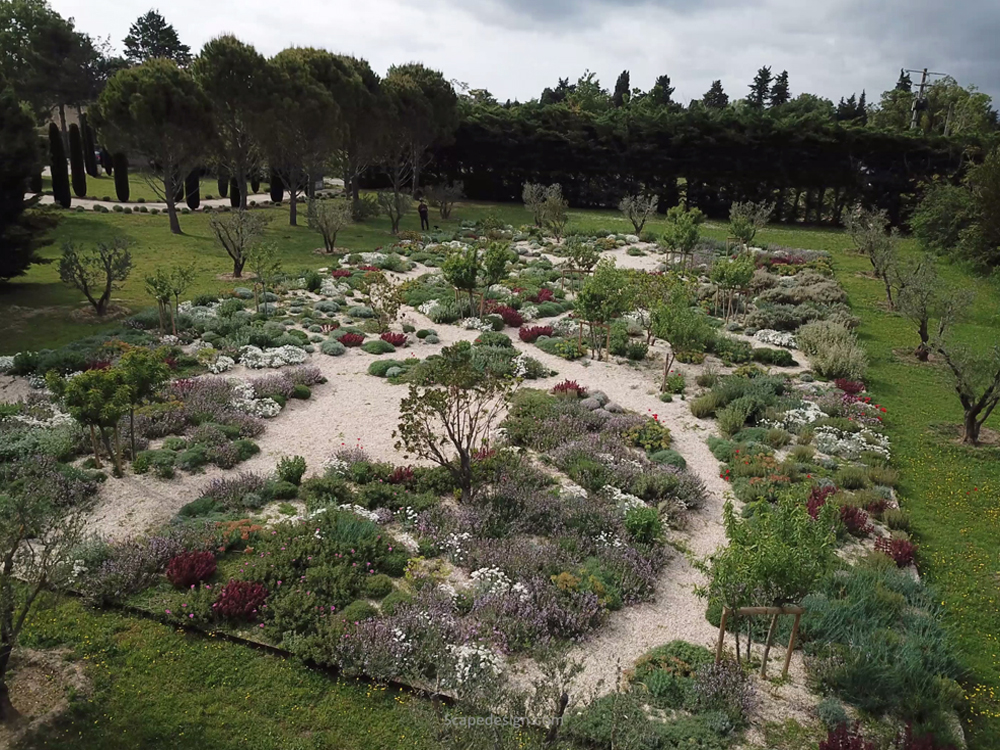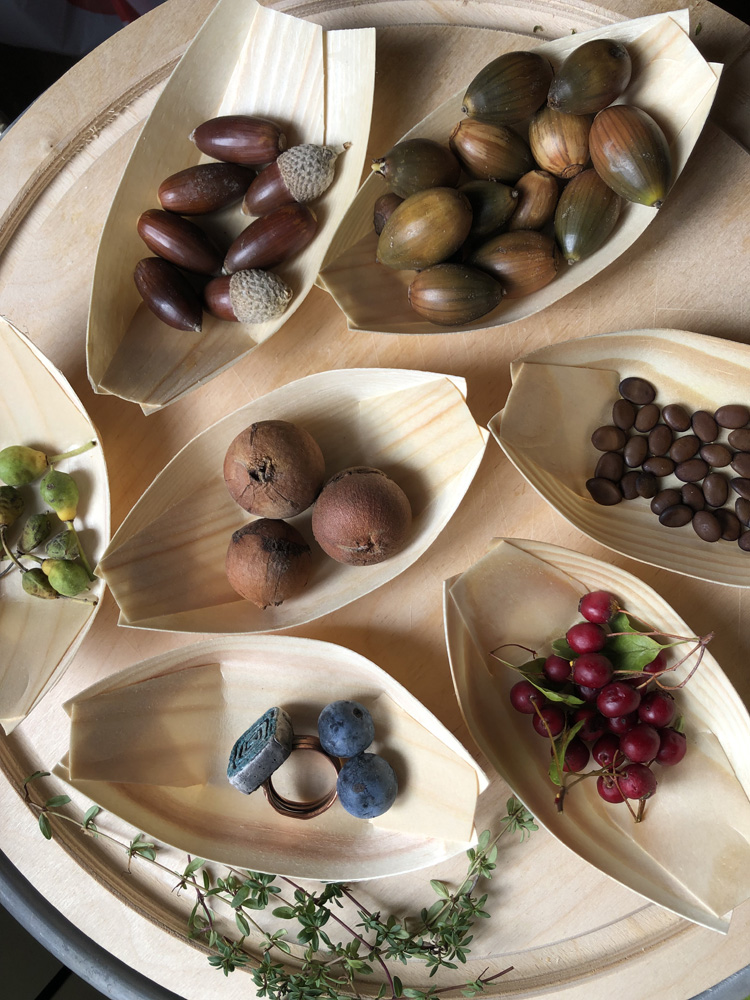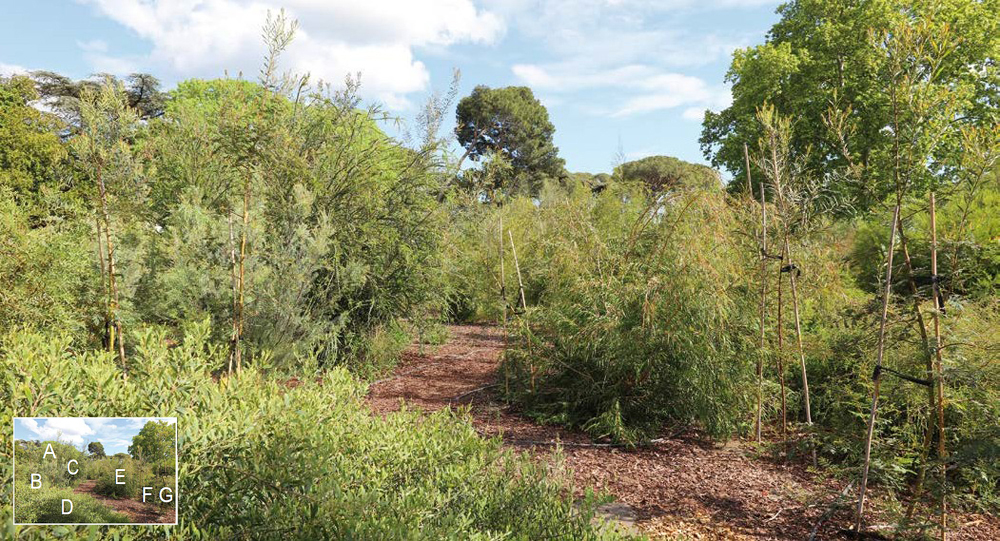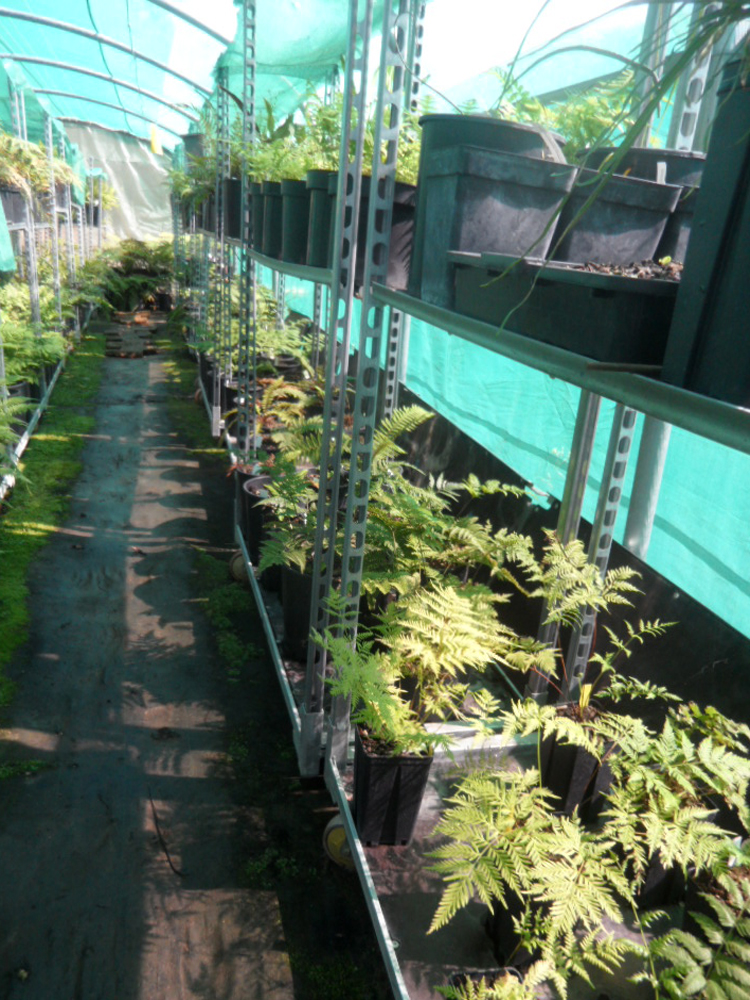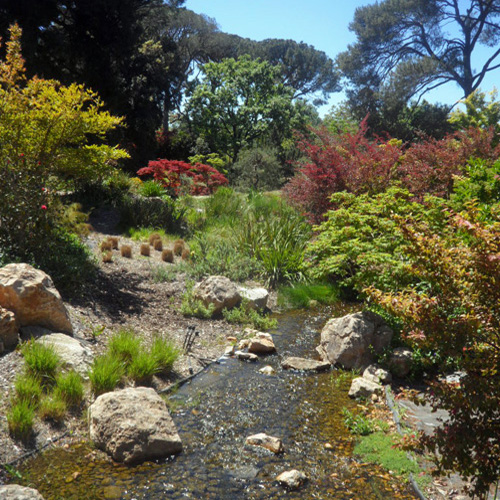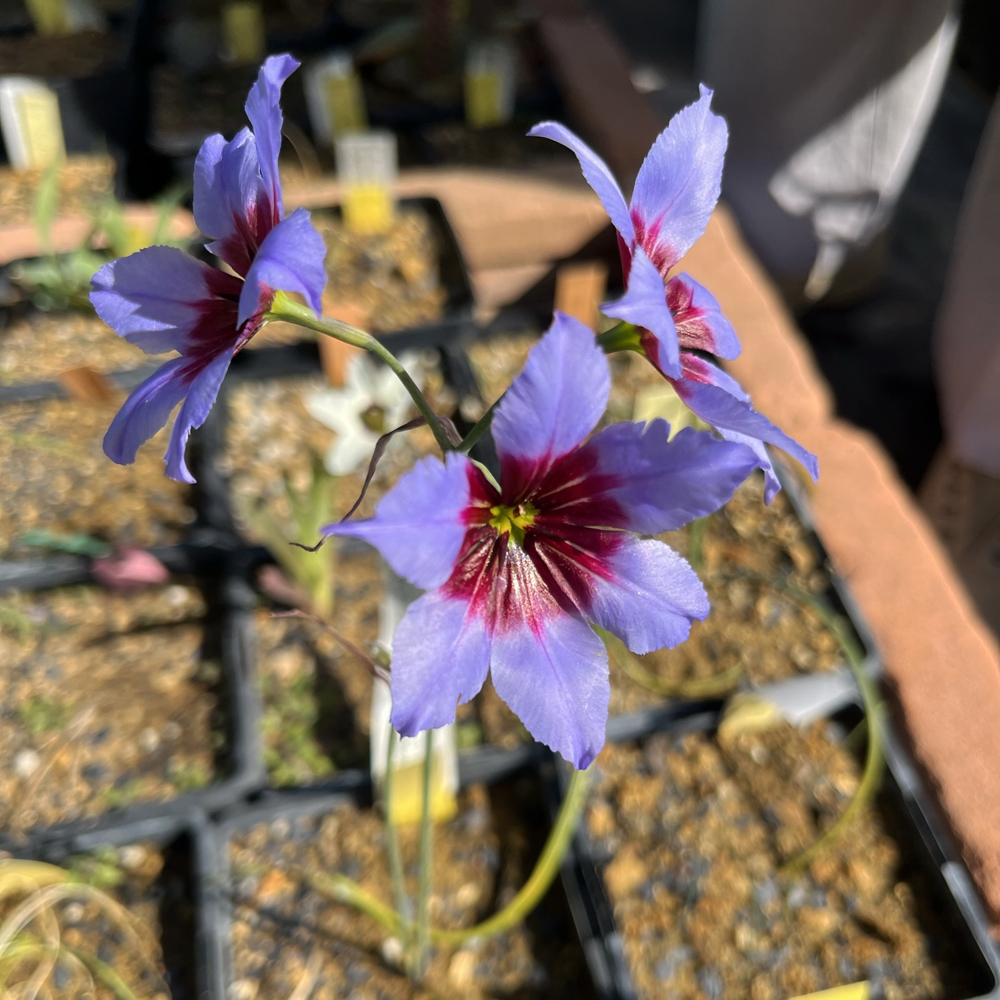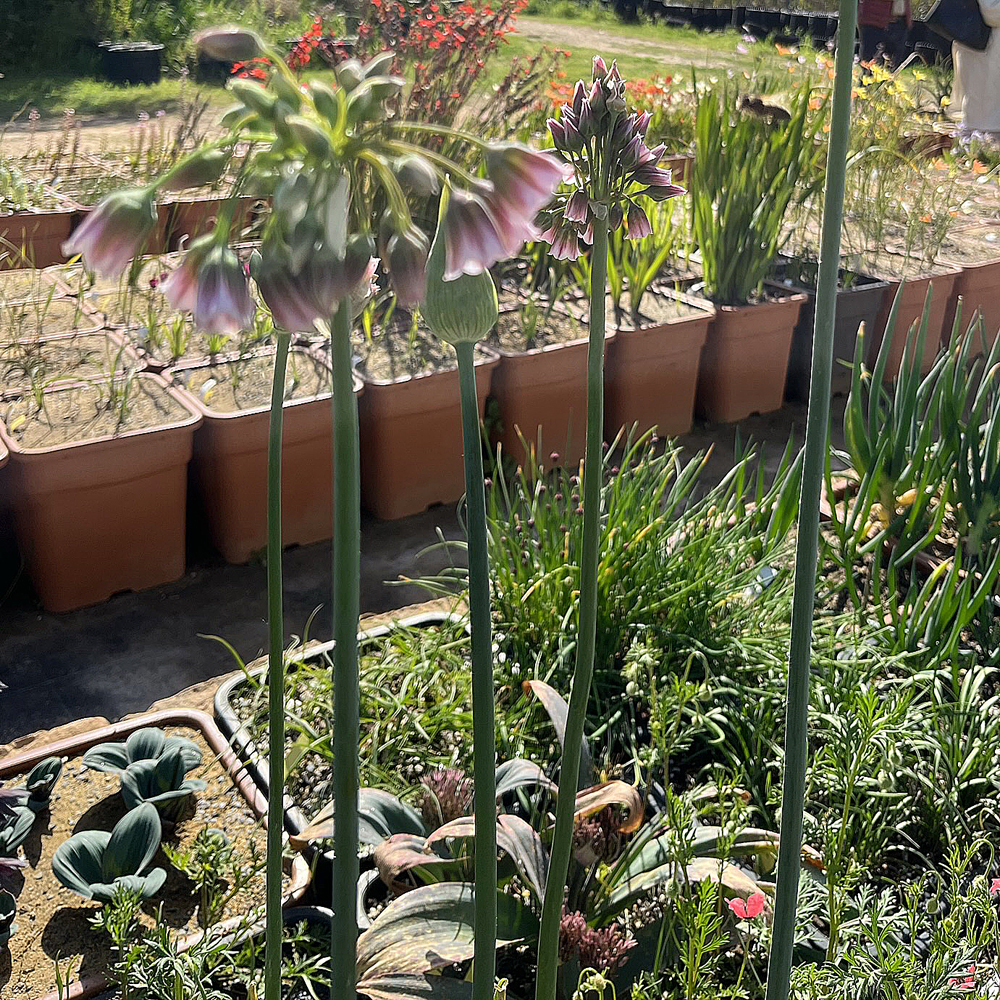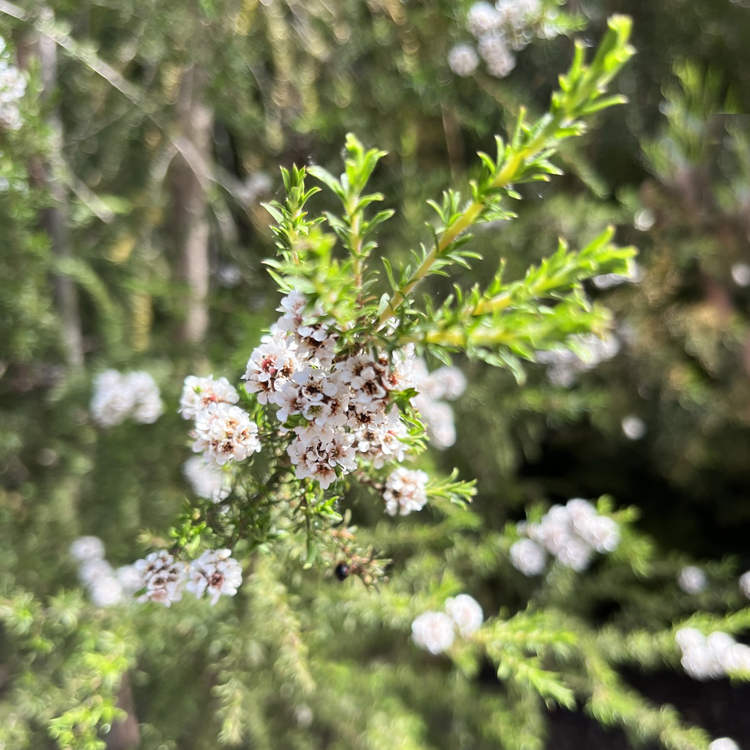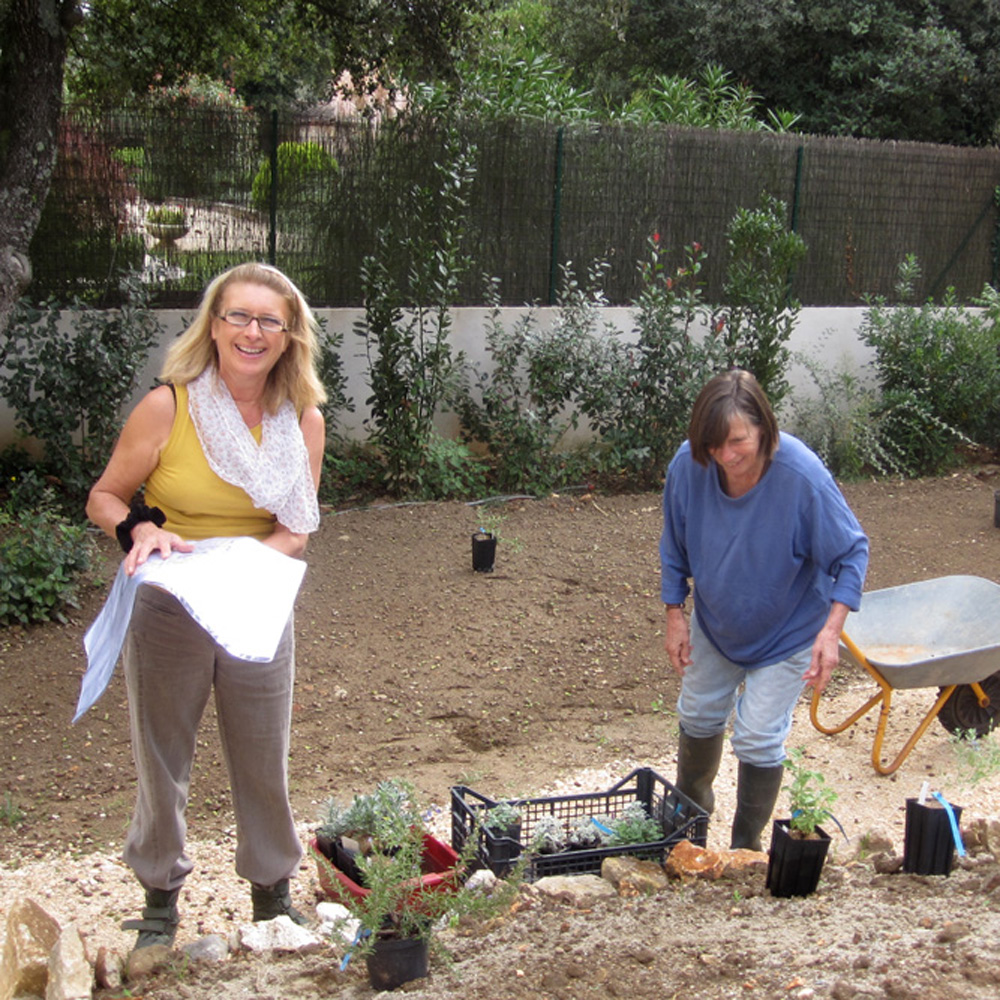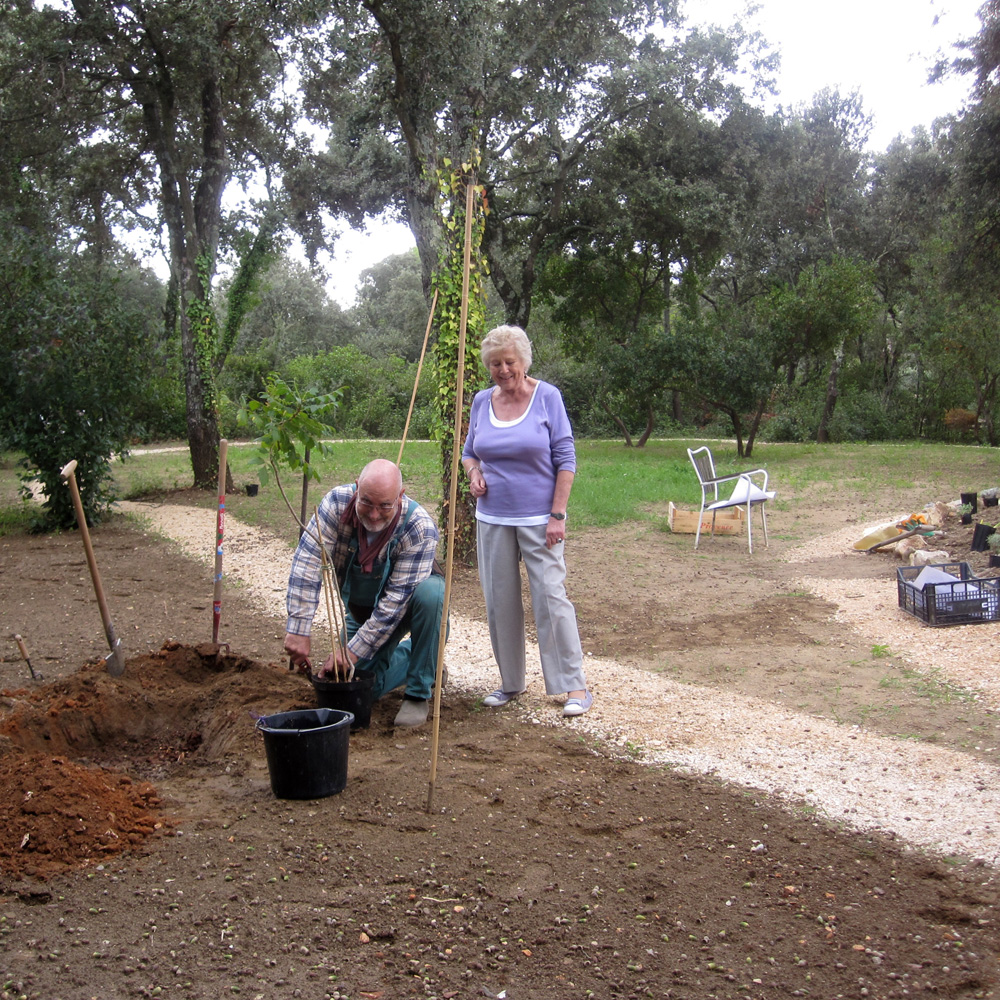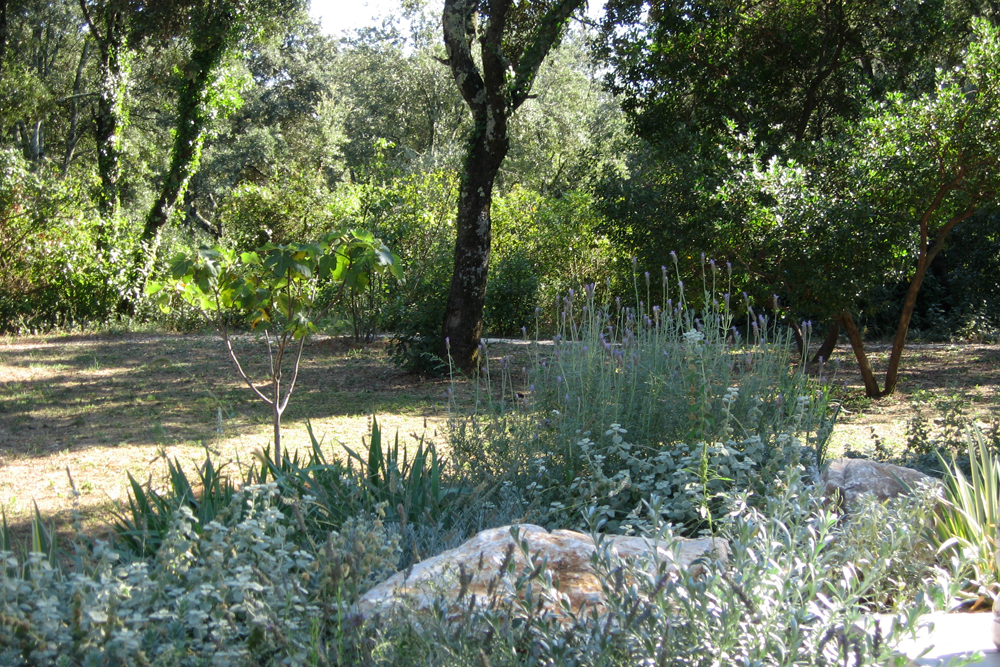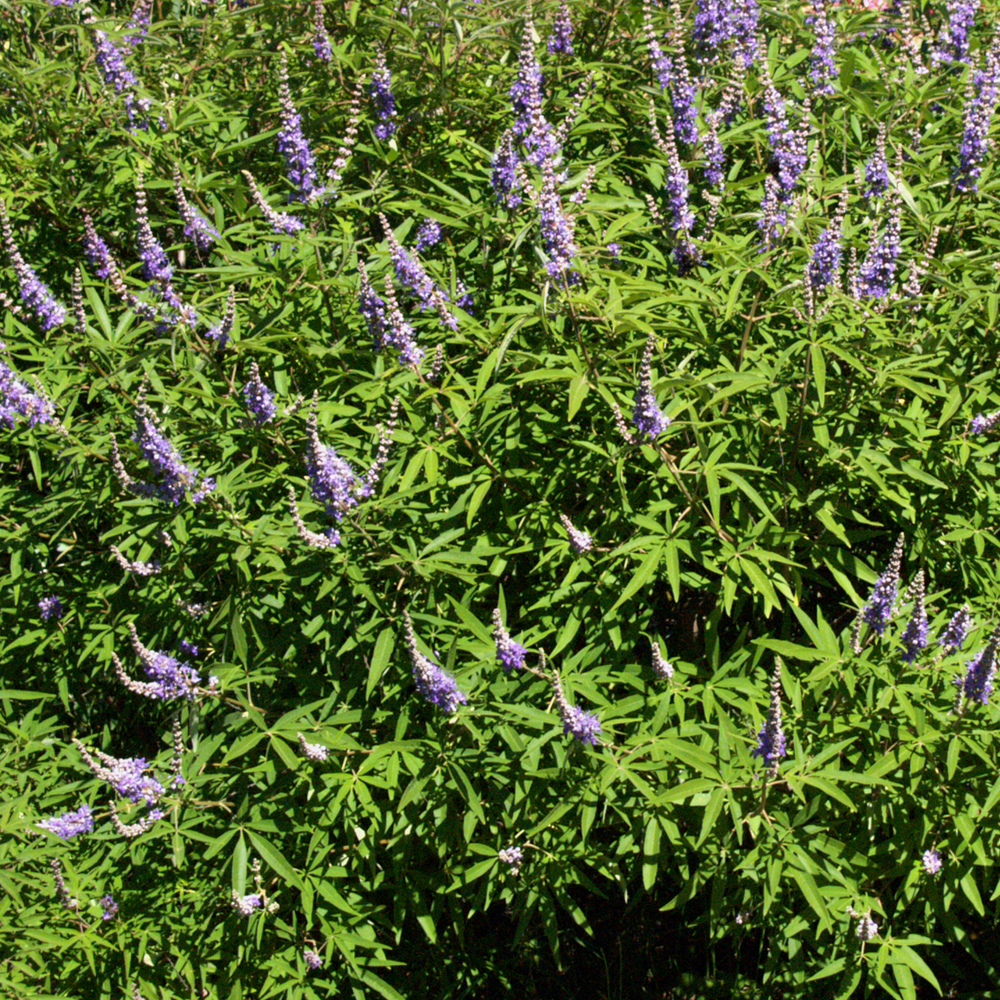A garden in Maussane-les-Alpilles
Un jardin à Maussane-les-Alpilles
Clare and Mark purchased their property in Maussane-les-Alpilles in 2012. The house is set in several hectares of garden and fields, with views across to the Alpilles to the north. In 2017, James Basson, British garden designer and Chelsea Gold medalist, was commissioned to redesign part of the garden. The brief was to create graveled areas planted with low maintenance Mediterranean plants requiring little or no watering.
Clare et Mark ont acheté leur propriété en Maussane-les-Alpilles en 2012. La maison est située dans plusieurs hectares de jardins et de champs, avec vue sur les Alpilles au nord. En 2017, James Basson, concepteur de jardins britannique et médaillé d’or de Chelsea, avait été chargé de redessiner une partie du jardin. Le brief était de créer des zones de gravier plantées de plantes méditerranéennes nécessitant peu ou pas d’arrosage.
Click on the images to enlarge them / Cliquez sur les images pour les agrandir
May / mai 2018
In May 2018, Mark and Clare hosted an MGF visit, and Nanouk Pelen wrote this report.
En mai 2018, Mark et Clare ont organisé une visite MGF. Nanouk Pelen a rédigé ce rapport.
A long, curved drive lined with cypresses leads past the house, and a large sculpture of Rove goats, to a secluded parking area.
Une longue allée incurvée bordée de cyprès passe devant la maison et une grande sculpture de chèvres Rove, et mène jusqu’à un parking isolé.
.
.
The space in front of the house, previously covered with crazy paving, is now a graveled area dotted with drought loving plants, framed by two micocouliers.
L’espace devant la maison, auparavant recouvert d’un dallage irrégulier, est maintenant une zone gravillonnée parsemée de plantes aimant la sécheresse, encadrée par de deux micocouliers.
During lunch, Clare explained to us that in the previous year James Basson had started work on a design for the area beyond the drive, previously a large grassy field in which the children and grandchildren had often enjoyed a good game of football. It now includes a large rectangular gravel garden (ca. 18 x 10 m), surrounded by newly planted olive trees. James has designed the space to include four meandering paths and two square empty spaces, the future use of which is yet to be decided – sculptures, benches and pergolas are being considered.
Pendant le déjeuner, Clare nous a expliqué qu’au cours de l’année précédente, James Basson a commencé à travailler sur un projet pour la zone au-delà de l’allée, autrefois une grande prairie dans lequel les enfants et les petits-enfants avaient souvent apprécié un bon match de football. Ceci est maintenant un grand espace rectangulaire (d’environ 18 x 10 m) recouvert de gravier, entouré d’oliviers récemment plantés. James a conçu l’espace pour inclure quatre chemins sinueux et deux espaces vides carrés, dont l’utilisation future n’a pas encore été décidée – des sculptures, des bancs et des pergolas sont envisagés.
.
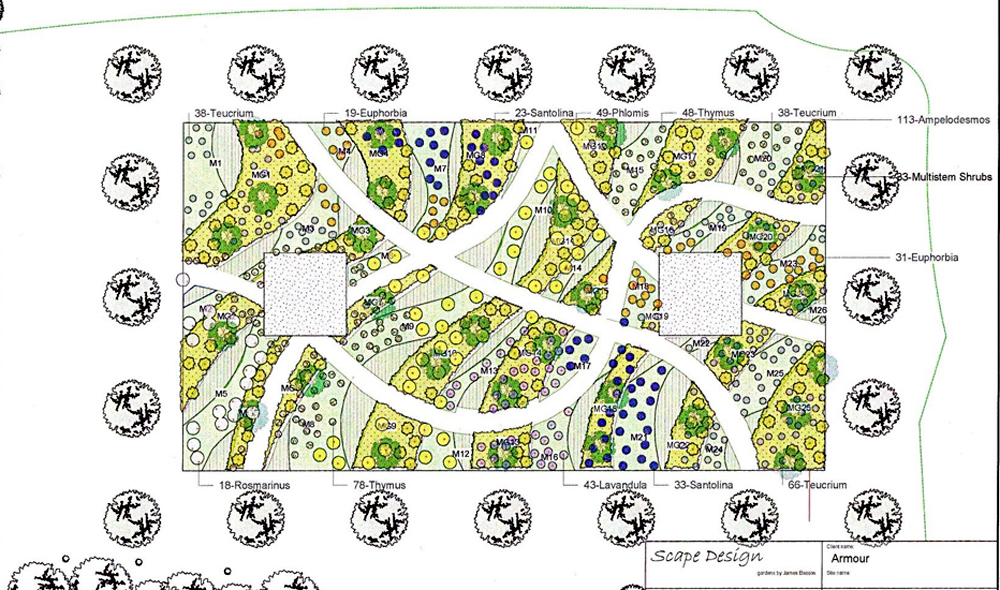
.
.
Between the paths are planted some 600 shrubs and grasses, including swathes of several varieties of thyme, lavender, santolina, euphorbia and rosemary, with teucrium and Ampelodesmos mauritanicus running throughout. Dotted here and there are taller multi stem shrubs such as Pistacia terebinthus, Phillyrea latifolia and Amelanchier ovalis. The whole area was planted up in the autumn of 2017.
Entre les chemins sont plantés environ 600 arbustes et herbes, y compris des bandes de plusieures variétés de thym, de lavande, de santoline, d’euphorbe et de romarin, et parsemé de teucrium et Ampelodesmos mauritanicus. Ici et là se trouvent des arbustes à plusieurs tiges plus hauts, tels que Pistacia terebinthus, Phillyrea latifolia et Amelanchier ovalis. Toute la zone a été plantée en automne 2017.
.
.
After lunch we spent an enjoyable and interesting time visiting the new garden, then wandered over to the raised gardens surrounding the pool. Clare and Mark have recently had the pool house’s three inner walls painted by British artist Terence Clark, and plan to redesign the planting in this area. A lovely courtyard lies behind the main house, in which a fountain danced merrily in the strong mistral.
Après le déjeuner, nous avons passé un moment agréable et intéressant à visiter le nouveau jardin, puis nous nous sommes promenés dans les jardins surélevés entourant la piscine. Clare et Mark ont récemment fait peindre les trois murs intérieurs du pool house par l’artiste britannique Terence Clark, et prévoient de réaménager la plantation dans cette zone. Une belle cour se trouve derrière la maison principale, dans laquelle une fontaine dansait gaiement fouettée par un fort mistral.
.
.
It will be fascinating to revisit the gardens in a few years’ time, when the newly designed area will have matured and become a wonderful example of a Mediterranean dry garden. A heartfelt thank you to Clare and Mark for a delightful visit!
Il sera fascinant de revisiter les jardins dans quelques années, lorsque la zone nouvellement conçue aura mûri et deviendra un merveilleux exemple de jardin sec méditerranéen. Un grand merci à Clare et Mark pour cette merveilleuse visite !
Text: Nanouk Pelen
Photos: Hugues Pelen
2020
By 2020, the planting had started to fill out, as these photographs, taken by Clare, demonstrate.
Dès 2020, les plantations ont commencé à se développer, comme le montrent ces photos prises par Clare.
.
.
.
The planted areas are on specially created low mounds, to a height of around 25 cm, using a mixture of soil and gravel. The intervening gravel pathways act as drainage channels after heavy rain. The planting is intricate, incorporating numerous varieties of salvia, thyme, rosemary and lavender, together with achillea, artemisia, santolina and globularia. Structure is supplied by the almond trees, cistus, Pistacia lentiscus, Myrtus communis and Phillyrea angustifolia.
Les massifs plantés se trouvent sur des buttes basses, d’une hauteur d’environ 25 cm, aménagées à l’aide d’un mélange de terre et de gravier. Les allées de gravier intermédiaires servent de canaux de drainage après les fortes pluies. La plantation est complexe et comprend de nombreuses variétés de sauge, de thym, de romarin et de lavande, ainsi que des achillées, des armoises, des santolines et des globulaires. Les amandiers, les cistes, Pistacia lentiscus, Myrtus communis et Phillyrea angustifolia apportent une structure à l’ensemble.
These photographs, taken by the designer, James Basson, ©Scape Design ,show how the garden looked through the seasons.
Ces photos, prises par le designer James Basson, ©Scape Design, montrent l’aspect du jardin au fil des saisons.
.
.
.
Clare has supplied this list of some of the key plants in the garden:
Clare a fourni cette liste de quelques plantes clés du jardin :
Achillea millefolium
Achillea umbellata
Allium tuberosum
Artemisia arborescens
Bupleurum gibraltaricum
Calamintha nepeta
Catanache caerulea
Centaurea bella
Eryngium amethystinum
Euphorbia cyparissias
Euphorbia rigida
Globularia alypum
Iris lutescens
Lavandula angustifolia ‘Hidcote Blue’
Phlomis purpurea subsp. almeriensis
Phyla nodiflora
Prunella hyssopifolia
Salvia clevelandii ‘Allen Chickering’
Salvia multicaulis
Santolina viridis ‘Primrose Gem’
Stachys cretica
Teucrium flavum
Teucrium fruticans ‘Ouarzazate’
Teucrium marum
Thymus capitatus
Thymus vulgaris ‘Elsbeth’
2023
After much discussion, in 2021, the two square empty spaces where the four meandering paths meet, were filled with rusted metal pergolas. These create focal points, provide shade, and add a height dimension.
Après de nombreuses discussions, en 2021, les deux carrés vides où se rejoignent les quatre chemins sinueux ont été comblés par des pergolas en métal rouillé. Celles-ci créent des points focaux, fournissent de l’ombre et ajoutent une dimension de hauteur.
.

.
In 2023, Marianne Majerus, renowned garden photographer, visited the garden. She very kindly agreed to let us reproduce some of her photos on the MGF website. All the photographs on this page are copyright Marianne Majerus.
En 2023, Marianne Majerus, photographe de jardin renommée, a visité le jardin. Elle a gentiment accepté que nous reproduisions certaines de ses photos sur le site web de la MGF. Toutes les photos de cette page sont protégées par le droit d’auteur de Marianne Majerus.
.

.

.
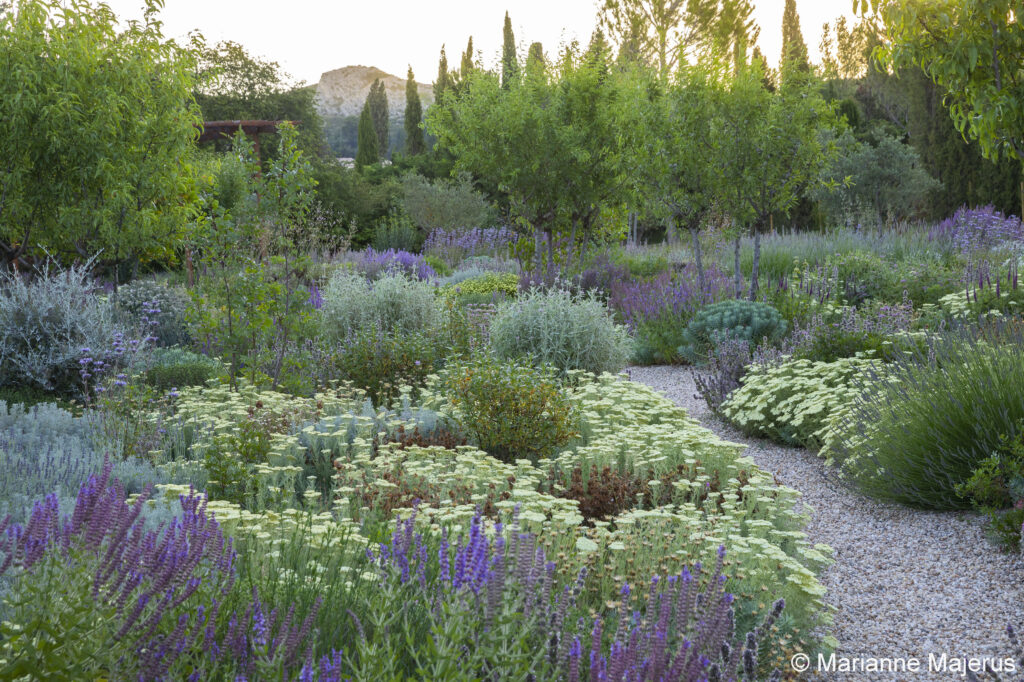
.

.

.

.

.

Text: Christine Daniels
Photos: Marianne Majerus
![]()












